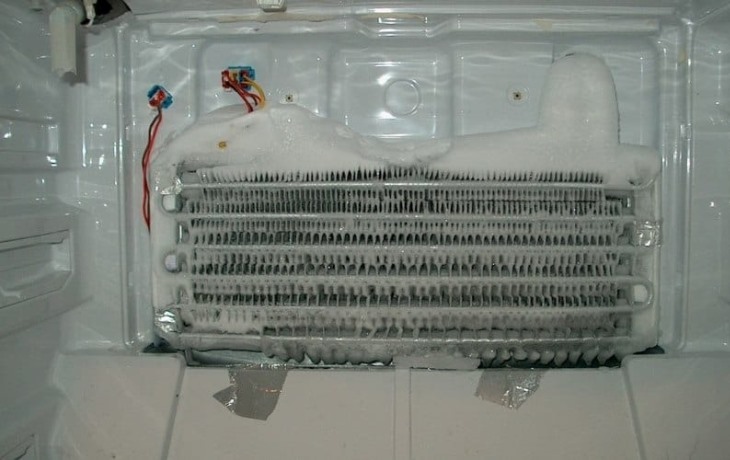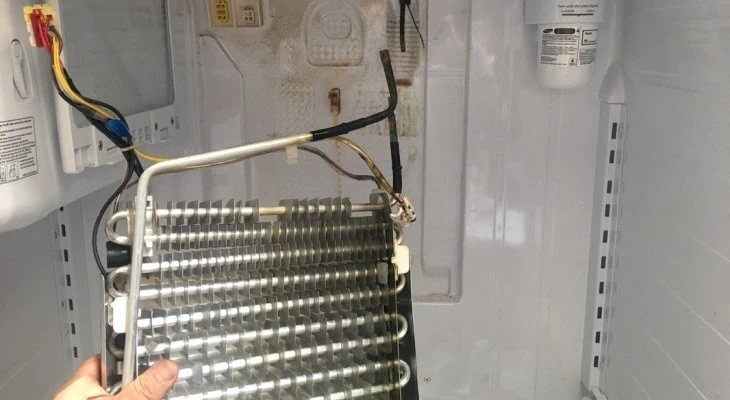If the back of your fridge looks like a scene from ‘Ice Age’, there is definitely a problem. The fridge should be a place to keep things cold, but not frozen.
Why is there a sheet of ice at the back of the fridge, anyway? How can you get rid of the ice? What’s the best way to keep your fridge from freezing in the first place? Let’s find out!
Ice build-up in the back of the refrigerator could be due to warm air leaking into the refrigerator due to the door being frequently opened, or faulty seals. There also could be a problem with the defrost system, such as a clogged defrost drain or a system malfunction. Manually defrosting the refrigerator is the best way to get rid of the ice build-up.
Table of Contents
Why is there Ice in the Back of the Fridge?

Ice build-up in the back of the fridge is usually caused by warm air in the fridge, or a problem with the defrost system. The back of the refrigerator is the coldest part. If there is moisture build-up in the fridge, when it comes into contact with the back of the fridge, it may freeze.
Air Leaks
Warm, moist air is the biggest culprit for ice buildup. If this air gets into the fridge and hits the cold part at the back, it could freeze into ice.
Air can get into the fridge if it is opened and closed a lot. Prevent this by limiting the amount of time the fridge door is open.
Check the seals, gaskets, and hinges, as well. If the seals are broken, air can get into the fridge. Check your refrigerator’s manual. Changing the seals is usually a relatively simple job.
Clogged Defrost Drain

There’s a small drain in the bottom of the refrigerator that allows moisture to drain out of the fridge. Sometimes, this drain can freeze and get blocked with ice. When this happens, moisture will not drain and can turn into an ice build-up.
Thankfully, this is an easy fix! You just need to melt the ice in the drain. Carefully pour hot water into the drain until the block is melted, and the water can drain easily.
Faulty Defrost System
The defrost system keeps the refrigerator from freezing. It consists of the defrost thermostat that senses the temperature at the back of the fridge, and the defrost heater. The heater kicks on when the back of the fridge gets too cold in order to keep ice from forming.
If the thermostat fails, the heater will not kick on and melt ice build-up. If the defrost heater fails, it won’t melt the ice. In order to fix the problems, you need to determine which part of the defrost system is at fault, then replace it.
How Can I Defrost the Fridge?

Once you figure out what is causing the ice, you need to remove the ice and make the necessary repairs. Check your owner’s manual for specific instructions on how to defrost your particular model of refrigerator. Here are general instructions on how to defrost your refrigerator.
Step-by-Step Instructions
- Remove everything from the fridge and the freezer. Either move everything to another fridge and freezer or try to eat as much of it as possible.
- Unplug the fridge.
- Open the doors. You may need to prop them open, but you want to allow the fridge to reach room temperature.
- Place drip pans and towels around the fridge. As the ice melts, it will run out of the refrigerator.
- Allow the fridge to defrost. It usually takes about 24 hours for the fridge to fully defrost.
- Wipe out the fridge. Now that the fridge is empty and thawed, it is a great time to give it a thorough cleaning! Dry it out completely once you’re done.
- Plug the fridge in. Plug it back in, and keep an eye on it while it returns to normal temperatures. Watch for ice build-up again. This is a sign that you need to make further repairs or call a repairman.
When to Call a Professional
If you have changed the gaskets, adjusted the temperature, cleaned the drain, and replaced components in the defrost system, and you’re still dealing with ice build-up, it is probably time to call a professional. Or, if you do not have time to figure out the ice problem on your own, let a professional handle the problem.
What’s the Best Way to Stop the Fridge from Freezing?
Keep ice from building up in the first place with these tips.
Keep the Doors Closed
Only open the doors when necessary, and avoid standing in front of the fridge with the doors wide open. Make sure your family knows this rule, too! This will minimize the amount of warm, moist air that gets into the fridge.
Replace Broken Seals
Check all the seals and gaskets for air leaks, and replace them as necessary.
Place Produce in the Crisper

Fruits and vegetables have a high moisture content that can evaporate and freeze at the back of the fridge. Store them in the crisper drawer to keep the moisture contained.
Let Hot Foods Cool
Don’t place hot foods in the fridge right away. Let them cool on the counter first. As food cools, it releases warm, moist air which could condense and freeze on the back of the fridge.
Set the Thermostat Correctly
Typically, the refrigerator thermostat should be set between 37 and 40 degrees Fahrenheit (3-4 degrees Celsius), and the freezer at 0 degrees Fahrenheit (-18 degrees Celsius). If you think the thermostat is off, purchase a separate thermometer to test the temperature, and adjust it accordingly.
Final Thoughts
Don’t let a frozen fridge ruin your groceries! Manually defrost your refrigerator. Once it is defrosted, you can determine what caused the ice build-up in the first place. Make your repairs, plug in the fridge, and you should be cool, but not frozen, in no time!

